Cookbook #211: Beard on Pasta, James Beard, Alfred A. Knopf, NY, 1983.
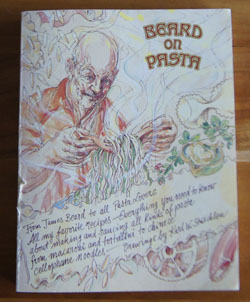
James Beard was a well-known and well-loved twentieth century American cook, author, teacher, and television personality. I covered his book Beard on Bread in my fifth 250 Cookbooks post, and he wrote many articles in my Encyclopedia of Cookery volumes. I enjoy his writing, and his wisdom. So I am happy to now cover Beard on Pasta.
“This is a book of good times to have with pasta.” So begins the introduction of Beard on Pasta. He continues: “I never get tired of pasta, any more than I get tired of bread.” I am the same way!
Noodles have a long history. Before refrigeration, wheat was mixed with water to make a paste that was dried to become “noodles”, and these could be stored at room temperature without spoiling. According to Beard, in early Bulgaria lumps of dried dough were carried by horsemen in their saddlebags and grated into pots of boiling milk at the end of the day’s ride. Records show that noodles were being sold in Greece as early as the fifth century. “Pasta in Italy probably started in the south, as part of that whole Mediterranean culture. We know that Romans grew wheat in Sicily.”
We tend to think of noodles as Italian, but pasta is a part of nearly every country’s cuisine. Noodles are made from wheat flour, rice flour, and mung bean, yam, potato, and cassava starches. Noodles are made in all shapes and sizes. Some noodles require boiling before adding to a dish, and some only need to be soaked in cold water.
A quote from Beard: “We’re Americans, with a whole melting pot of cultures behind us, and we don’t have to do things the classic Italian way. We can do as we please.” And: “this is not an Italian cookbook”.
The first chapter is “Observations”. Beard discusses commercial dried pastas, store-bought fresh pasta, equipment for making and saucing pasta, how to cook pasta, choosing portions, important ingredients (tomatoes, olive oil, cheese), and what to drink with pasta. I like the way he does not judge between store-bought or homemade pasta, and he does not judge between pasta-making methods such as hand made, manual machines, or electric pasta-extruding machines. I like to use my manual pasta maker for simple flat noodles and spaghetti and for filled pastas like ravioli. I own an electric Simac pasta machine that both kneads and extrudes the dough. I don’t use it a lot anymore, but it is great for making fresh macaroni.
Also in the “Observations” chapter is a section on flour. Me and flour have a long relationship and I pay close attention to this section. Beard writes that the recipes in this book were all prepared with all-purpose flour. But he states that the best flour for pasta is durum (hard-wheat) flour. Durum flour has more gluten in it (gluten is the sticky stuff), but was hard to find in the US when he wrote the book in 1983. All-purpose flour is a blend of hard and soft wheats. Semolina is made from durum wheat, but in the US, it is sold as a coarsely ground product, and does not make a good, pasty dough. I do use semolina when I make my own pasta dough, but I always mix it with all-purpose flour, in a ratio of about 1 part semolina to 3 parts all-purpose flour.
While it is still hard to find durum wheat and other specialty flours in my local stores, I discovered King Arthur Flour online a couple decades ago. Today I can order durum flour, artisan bread flour, french-style flour, high gluten flour, and a pasta flour blend from King Arthur Flour.
The next chapter is “Making Pasta”. This chapter describes how to roll, cook, and dry homemade pasta. (I talked a lot about how I make pasta in this post: The New Pasta Cookbook – please refer to that post to learn about my method.) My age-old pasta dough recipe is 1 1/2 cups all-purpose flour, 1/2 cup semolina flour, 1/2 teaspoon salt, 1 tablespoon olive oil, 2 eggs, and 2-4 tablespoons water. Beard’s recipe is similar, but leaves out the semolina flour and the olive oil. He gives directions for making the dough by hand, as well as using a food processor or a mixer.
The rest of the chapters include recipes for different pasta dishes: Pastas in Broth, Mainly Vegetable, Fish and Seafood, Meats, Eggs and Cheese, Stuffed Pastas, Cold Pasta, Small Saucings, and Desserts. The only recipe I marked in this book is “Chilied Short Ribs over Corn Macaroni”. I almost made “Italian Sausage Salad” for this blog and will definitely make it some hot summer night (oddly enough, we are having a very cool August in Colorado). In the Desserts chapter, I discover a recipe for “Noodle Pudding”, with broad noodles, eggs, sugar, spices, apples, raisins, and apricots. This “famous Jewish specialty” really sounds like the elusive kuchen recipe that a college friend made for us all those years ago!
To sum up: this book is a great source for pasta recipes. It’s a keeper!
Now, what to make for this blog? Beard inspires me to be creative and trust my own judgement, to explore, to substitute ingredients, to use what is on hand in my household. So that is what I am going to do for this blog post.
First I’ll make my own pasta. I haven’t made pasta from scratch for a long time, maybe just couple times since my December 2012 post on The New Pasta Cookbook. In that post, I show and discuss my manual pasta machine. Briefly, it rolls the dough into thin sheets, and then it cuts those sheets into flat noodles or spaghetti.
I have a bag of “Perfect Pasta flour blend” in my pantry. It is:
“a blend of golden semolina, durum flour, and King Arthur Unbleached All-Purpose Flour” (ordered online from King Arthur Flour)
Yes! It has the durum flour touted by James Beard. The problem is, the package should have been used by 2015 (and it’s 2017). It is still sealed, so I open the package and carefully look for bugs. None. I give it a big sniff: does it smell a little stale? Maybe, but I think it’s okay. The recipe on the package back is:
- 3 cups Perfect Pasta Flour Blend
- 4 large eggs
- 2-4 tablespoons water
- a little extra flour for the work surface
The directions say to mix in a food processor, bread machine, or by hand in a bowl. Bread machine?! Hey, I’ve never mixed pasta dough in a bread machine, I think I’ll try it!
I have three beautiful, delicious summer tomatoes from the local produce stand. And I have basil, oregano, and thyme in my garden. I decide to make Beard’s Fresh Tomato Sauce:
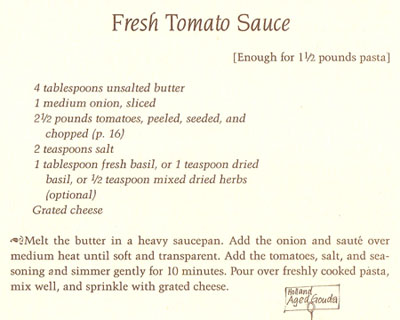 The tomatoes need to be peeled, seeded, and chopped, and Beard has directions for this on page 16. In a class at the Auguste Escoffier School of Culinary Arts in Boulder, I was taught to cut out the top stem end of the tomato, score an X on the bottom, boil for 30 seconds, chill the tomato in an ice bath, peel the tomato, cut it in half, and then scoop out the seeds. Beard’s directions on page 16 of Beard on Pasta are much simpler. The tomatoes are boiled “as is” for 30 seconds, then you slice off the top, squeeze out the juice and seeds, peel the tomato, and chop it up. I tried Beard’s method and liked it. Here is my “Fresh Tomato Sauce”.
The tomatoes need to be peeled, seeded, and chopped, and Beard has directions for this on page 16. In a class at the Auguste Escoffier School of Culinary Arts in Boulder, I was taught to cut out the top stem end of the tomato, score an X on the bottom, boil for 30 seconds, chill the tomato in an ice bath, peel the tomato, cut it in half, and then scoop out the seeds. Beard’s directions on page 16 of Beard on Pasta are much simpler. The tomatoes are boiled “as is” for 30 seconds, then you slice off the top, squeeze out the juice and seeds, peel the tomato, and chop it up. I tried Beard’s method and liked it. Here is my “Fresh Tomato Sauce”.
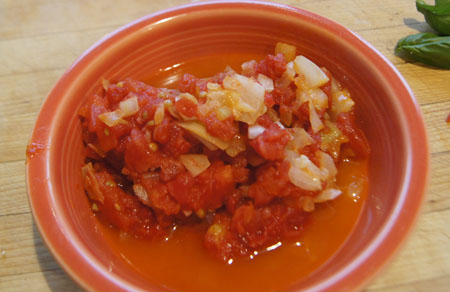 I am inspired by Beard’s “Pasta with Beans” recipe on page 90. The ingredients are: white beans, bacon, onions, carrots, herbs, canned tomatoes, and elbow macaroni. I have some great home-cooked flageolet beans in my freezer. I have leftover ham to use instead of bacon. My daughter gave me a big zucchini from her garden. I have a good red pepper. Herbs I have in abundance! I’ll use the fresh tomato sauce (above). And, of course, I will have my homemade flat noodles.
I am inspired by Beard’s “Pasta with Beans” recipe on page 90. The ingredients are: white beans, bacon, onions, carrots, herbs, canned tomatoes, and elbow macaroni. I have some great home-cooked flageolet beans in my freezer. I have leftover ham to use instead of bacon. My daughter gave me a big zucchini from her garden. I have a good red pepper. Herbs I have in abundance! I’ll use the fresh tomato sauce (above). And, of course, I will have my homemade flat noodles.
Here are the julienned zucchini and red pappers and herbs:
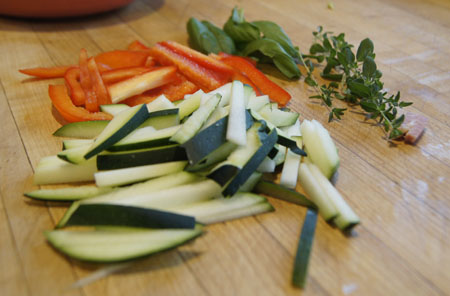
I saute the ham with some garlic:
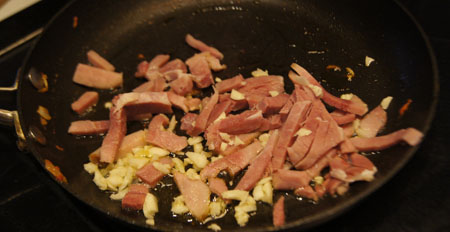 Beard is big on cheese. But, I don’t have a lot of good, chunk Parmesan cheese in my refrigerator – and I’ve decided to make this meal with what I have on hand. I sniff all my cheeses, grate up the last (hard) chunk of Parmesan, add a bit of another sharp white cheese, and use the last of my pre-shredded Parmesan.
Beard is big on cheese. But, I don’t have a lot of good, chunk Parmesan cheese in my refrigerator – and I’ve decided to make this meal with what I have on hand. I sniff all my cheeses, grate up the last (hard) chunk of Parmesan, add a bit of another sharp white cheese, and use the last of my pre-shredded Parmesan.
 I made a loaf of My Daily Bread to go with the pasta:
I made a loaf of My Daily Bread to go with the pasta:
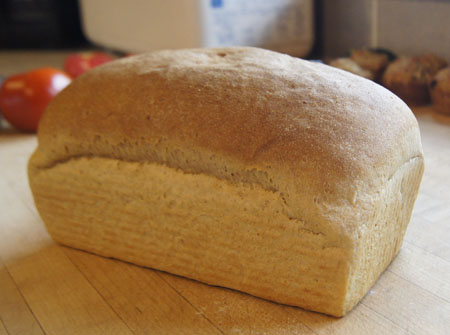
And here is my pasta dish:
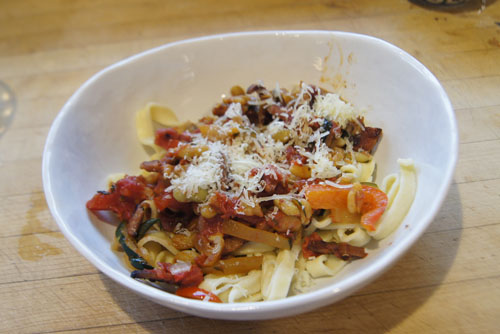
It was absolutely delicious! So fresh and so full of flavor. The noodles were cooked al dente, and definitely a bit thick, and had just the right amount of chewiness. Such a great meal that we decided to open a bottle of red wine. Yum, what a treat on a Thursday night.
Thank you James Beard for encouraging me to be creative.
Note: I don’t think I’ll use the bread machine to knead the dough next time. The pasta dough was a bit too wet, and fell apart if I tried to get my manual pasta machine to roll it thinner than the “4” setting (“6” is the thinnest). Next time, I’ll go back to using my trusty Kitchen Aid mixer for the dough.
